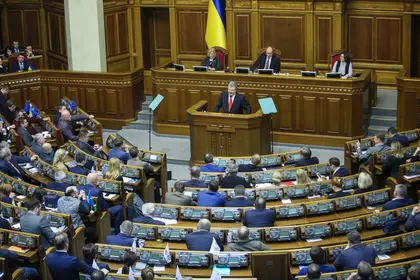Ukraine’s parliament approved late on Nov. 26 the imposition of 30 days of martial law in 10 oblasts located on the Russian border, the border with the Russian-controlled Transnistria region of Moldova and oblasts located by the Black and Azov seas.
The 276 lawmakers out of 330 present in parliament voted in favor of a bill by President Petro Poroshenko who proposed it in response to Russian escalation in the Black Sea.
Russian military vessels captured three Ukrainian military speedboats with 23 crew members in the Black Sea on Nov. 25. The ships and the crew members are still being held in Russian-controlled Kerch. Three of the men are wounded and hospitalized.
In an address to the nation that preceded the vote, Poroshenko said martial law will take effect at 9 a.m. Kyiv time on Nov. 28. It will include Vinnytsia, Luhansk, Donetsk, Zaporizhia, Mykolayiv, Odesa, Sumy, Chernihiv, Kharkiv and Kherson oblasts.
It will enable the military to take over control over these areas and restrict the civic and political rights of their residents. The text of the bill is still now published and the lawmakers voted for it based on the oral presentation of parliament speaker Andriy Parubiy.
Parliament passed it after 10 hours of backroom discussions and disputes in the meeting hall, amid swearing and insults.
Many found it odd to impose the martial law in the fifth year of Russia’s war against Ukraine and claimed Poroshenko offered the bill to postpone the presidential elections in 2019. According to recent polls, he has the highest negative rating among all the candidates and low chances to win.
Under pressure, Poroshenko agreed to limit martial law to 30 days instead the earlier planned 60 days and restrict its scope to 10 oblasts instead of the entire territory of Ukraine.
Speaking in parliament, Poroshenko also assured the lawmakers he was going to implement the martial law “explicitly in case of the Russian aggression on the ground.” Otherwise, there will be no limitations of the human rights in these areas, he said.
The lawmakers also approved scheduling of presidential elections for March 31, 2019.
They also approved a resolution urging the West to stop Russian aggression, provide military aid to Ukraine and send observers and warships to the Black Sea and the Sea of Azov.
It is possible that martial law could be extended if Russian aggression persists. But it’s not clear what would trigger its continuation and whether parliament needs to approve such an extension, or Poroshenko could act by executive order.
But Oleksandr Turchynov, secretary of the National Security and Defense Council, told lawmakers that martial law would be abolished by the end of this year “if there’s no more Russian aggression.”
Kyiv Post staff writer Oleg Sukhov contributed to this report.
You can also highlight the text and press Ctrl + Enter





